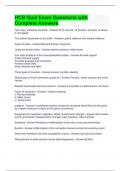HCB Quiz Exam Questions with
Complete Answers
How many vertebrae are there - Answer-33 (7 cervical, 12 thoracic, 5 lumbar, 5 sacral,
4 coccygeal)
Two distinct landmarks in the ankle - Answer-Lateral malleous and medial malleous
Types of joints - Answer-Ball and socket, hinge joint
Joints are formed when - Answer-bones connect to other bones
Five main functions of the musculoskeletal system - Answer-Provide support
Protect internal organs
Provides leverage and movement
Produce blood cells
Store minerals and lipids
Three types of muscles - Answer-visceral, cardiac, skeletal
Muscle pain is most commonly caused by - Answer-Tension, stress overuse and minor
injuries
Skeletal injuries(aka fractures) involve - Answer-A complete or partial break in the bone
Types of stretchers - Answer-i. Stokes stretcher
ii. Reeves stretcher
iii. Miller board
iv. Spine board
priapism - Answer-A persistent erection caused by excessive blood flow into the penis
as a result of trauma or injury to the pelvis or perineum
Equipment for inspection, palpation, ROM, muscle tone/ strength - Answer-skin-marker
pencil, goniometer (measurement of angle), tape measure, reflex hammer
Erythema - Answer-Redness or inflammation of the skin or mucous membranes
Bursitis - Answer-Inflammation of the connective tissue structure surrounding a joint
Which two vertebrae are most susceptible to injury - Answer-Cervical and lumbar
What percent of ankle sprains involve lateral ligaments - Answer-85-90%
,What red flag symptoms should you rule out for lower back pain? - Answer-Recent
trauma, neurological deficits, bowel/ bladder problems, saddle anesthesia, weakness,
falls, night pain, sweats fever and weight loss, history of cancer, osteoporosis
risk factors for lower back pain - Answer-Age, activity, obesity, sedentary lifestyle,
physically strenuous work, psychosocial factors(anxiety, depression, stress), smoking
Differential diagnosis for low back pain - Answer-Renal calculi, abdominal aortic
aneurysm
Bulla - Answer-large vesicle or blister greater than one centimeter
Sources of Electricity burns - Answer-Alternating current, direct current, lightning
First degree burn involves only the - Answer-epidermis
first degree burn is also known as a - Answer-superficial burn
what are the three classifications of burn severity? - Answer-Minor, Moderate and
critical
What should you look for when inspecting the skin of a burn - Answer-Color, Erythema,
Edema, Ecchymoses, Lesions
What size syringe do you use for wound irrigation? - Answer-35-ml
Avulsions - Answer-Flaps of skin and tissues torn loose or pulled off completely
What would be documented in the subjective portion of a cellulitis diagnosis? - Answer-
Break in skin, pain and swelling, May have fever
Plan for Cellulitis - Answer-Immobilize and elevate, sterile saline dressings, tetanus
immunization if open wound, systemic antibiotics
Furnacle(boil) - Answer-Deep seated infection of the hair and sebaceous gland
What would be documented in the subjective portion of furuncle(boil) diagnosis? -
Answer-Acute onset of tender red nodule that becomes pustular
What would be documented in the objective portion of a furuncle diagnosis? - Answer-
Skin red, hot, tender, Center of lesion fills w pus
Plan for Furuncle - Answer-Apply moist, warm compress, May need to perform wound
irrigation and dressing change if drain procedure is completed, Routine culture is not
necessary
, Rule of 9s - Answer-Each upper extremity-9%
each lower extremity-18%
Anterior trunk- 18%
Posterior trunk- 18%
Head and neck-9%
Groin-1%
Plan/Treatment for wrist fracture - Answer-Pre hospital: SAM Splint, immobilize arm,
Inpatient/outpatient: Assess, Exam, Assist
What scale should muscle strength be graded on? - Answer-0/5 to 5/5
Patient carrying techniques - Answer-one-rescuer assist, Cradle carry, Pack strap carry,
Firemans carry, piggyback, Two-rescuer assist, Firemans carry w assist, extremity,
pain in the chest when blood supply to the heart is reduced and a portion of the heart is
not receiving enough oxygen - Answer-angina pectoris
a condition when the heart ceased generating electrical impulses (FLAT LINE) -
Answer-asystole
normal heartbeat and circulation have completely stopped - Answer-cardiac arrest
study of the heart - Answer-cardiology
actions taken to revive a person by keeping the person's heart and lungs working -
Answer-cardiopulmonary resuscitation
vessels that supply the myocardium - Answer-coronary arteries
diseases that affect the arteries of the heart - Answer-coronary artery disease
blood clot in a vein, usually a deep vein of the lower limbs - Answer-deep vein
thrombosis
fluid output exceeds fluid intake causing a decrease in the amount of fluid in body
tissues - Answer-dehydration
cool, pale, and moist/sweaty skin; sweating - Answer-diaphoresis
irregular, or absent heart rhythm - Answer-dysrhythmias
swelling from a build up of fluid in the body tissues - Answer-edema
loss of large amount of blood from the vessels, internal or external - Answer-
hemorrhage




